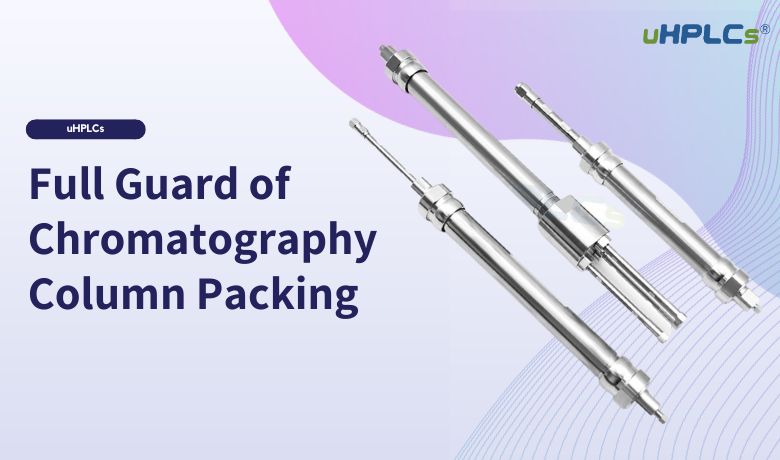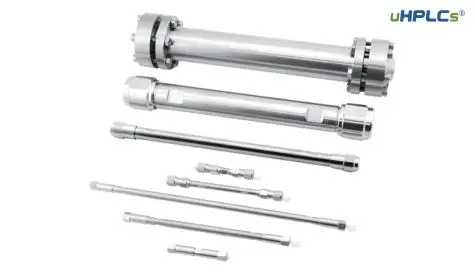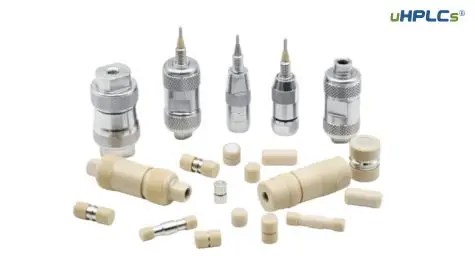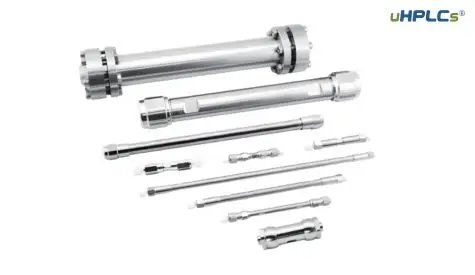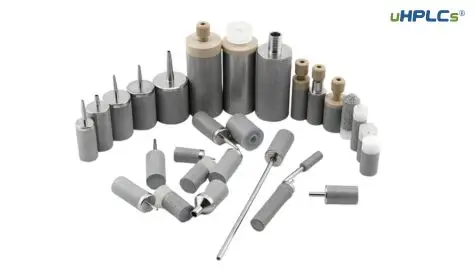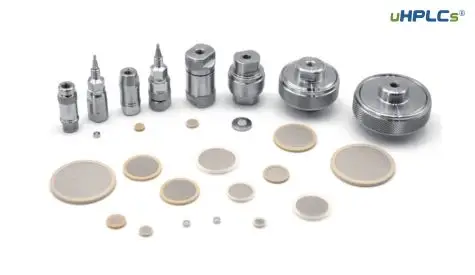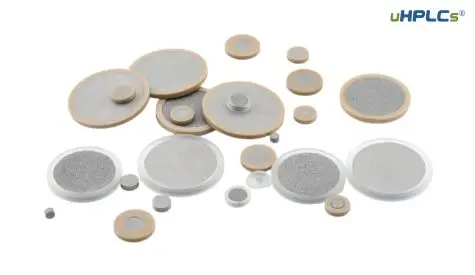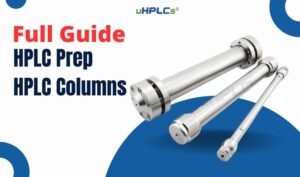1. Simple Introduction
Brief Overview of HPLC and its Significance
High-Performance Liquid Chromatography, commonly known as HPLC, is a widely utilized analytical technique in both research and industry. It serves as a powerful tool for the separation, identification, and quantification of various components in a mixture. From pharmaceuticals and food industries to environmental analyses, HPLC has a diverse range of applications due to its accuracy, precision, and adaptability.
The fundamental principle behind HPLC is the separation of molecules based on their interaction with a stationary phase inside a column, while being propelled by a mobile phase. The differences in the interactions (such as hydrophobicity, charge, or size) allow these molecules to elute at different times, creating distinguishable peaks that can be detected, often using UV-Visible detectors or other sophisticated detection systems.
Simple Say, Chromatography Column Packing is a Kind of Packing Tool to Make the Empty Column Hardware to be HPLC Column.
Importance of Column Packing in Chromatography
The heart of the HPLC system is the chromatography column. While many factors, including the mobile phase, temperature, and flow rate, play crucial roles in the separation process, the column, and more specifically, its packing material, stands out as the most pivotal.
Column packing involves the careful introduction of stationary phase materials (often fine particles) into the column. A well-packed column ensures uniform flow, high resolution, and reproducibility, while a poorly packed column can lead to anomalies such as band broadening, peak tailing, or even system blockages.
Achieving optimal packing isn’t merely about filling the column with material; it’s about understanding the nuances of the packing process, the material’s characteristics, and ensuring a consistent, void-free environment for the sample to interact with. For This article. We aims to delve deeper into the world of column packing, highlighting its nuances, challenges, and best practices.
Basics of Chromatography Column
Parts of a Column
A typical HPLC column consists of several key components:
Tube/Cylinder: This is the main body of the column, typically made from stainless steel, glass, or PEEK (polyether ether ketone). Its primary function is to hold the packing material securely.
End Fittings: Located at both ends of the column, these fittings help connect the column to the HPLC system. They are often equipped with frits or filters to retain the packing material inside the column and prevent any particles from escaping into the system.
Frits: These are porous discs or filters, usually made of stainless steel or sintered glass, that hold the packing material in place while allowing the mobile phase to flow through.
Guard Column: A smaller column placed before the main analytical column. It contains similar packing material and acts as a protective barrier, filtering out potential contaminants that might damage or foul the main column.
Material of Construction
The choice of column material is significant, especially when considering the types of solvents or conditions the column will be exposed to. Common materials include:
Stainless Steel: Preferred for its durability and resistance to high pressures. However, it might not be suitable for some corrosive solvents or buffer salts.
Glass: Mostly used for preparative columns and applications where metal-ion contamination could be an issue.
PEEK (Polyether Ether Ketone): A polymer material that’s resistant to many organic solvents. It’s used for bio-inert applications and instances where metal contamination is a concern.
Size and Dimensions of Common Columns
The size and dimensions of HPLC columns can vary widely depending on the application:
Length: Typical analytical columns range from 50 to 250 mm in length. However, preparative columns can be much longer.
Internal Diameter (ID): Analytical columns often have IDs between 2 to 4.6 mm, while semi-preparative and preparative columns might have larger IDs.
Particle Size: The packing material particle size can range from sub-2 µm (ultra-high performance) to 5 µm or more, depending on the desired separation efficiency and backpressure.
Selecting the right column size and dimensions is crucial as it impacts resolution, sensitivity, speed of analysis, and system pressure.
Types of HPLC Chromatography Column Packing ?
Here, Let’s Check How Many Types of HPLC Chromatography Column Packing, and Learn Details and Features of Each HPLC Column Packing.
1. Based on Particle Type:
Irregular Particles: Traditionally used in early HPLC columns, these particles have an irregular shape, often derived from crushed silica. Though they have largely been replaced by spherical particles, they are sometimes still used for specific applications.
Spherical Particles: These are the most common type in modern HPLC columns. Spherical particles provide more uniform flow paths, leading to better efficiency and reproducibility.
Monolithic Columns: Instead of using small particles, monolithic columns contain a single, continuous piece of porous material. They allow for faster flow rates and can provide rapid separations.
2. Based on Particle Size:
Sub-2 µm (UHPLC): Ultra-high-performance liquid chromatography (UHPLC) columns use these very small particles, enabling faster separations with higher resolution, though they require systems that can handle higher pressures.
3-5 µm: These are standard particle sizes for many analytical HPLC applications.
Larger than 5 µm: Often used for preparative HPLC, where the focus is on purifying larger quantities of material rather than achieving the highest resolution.
3. Based on Material:
Silica-Based: The most common material for reversed-phase chromatography. Silica particles are often modified with various functional groups to achieve desired chromatographic properties.
Polymer-Based: Often used when a wider pH range is needed, or when dealing with biomolecules that might interact unfavorably with silica.
4. Based on Functionalization/Modification (especially for silica):
C18 (Octadecyl): The most common type for reversed-phase chromatography, ideal for separating non-polar and moderately polar compounds.
C8, C4: Shorter carbon chains than C18, often used for larger molecules or when a less hydrophobic interaction is desired.
Phenyl, Cyano, Amino, etc.: These provide unique selectivities different from the alkyl chains.
Ion Exchange Materials: Used for ion-exchange chromatography, these materials are modified to carry charged functional groups. They can be cationic (for cation exchange) or anionic (for anion exchange).
Size Exclusion (Gel Filtration): These columns are packed with porous beads that separate molecules based on size. Larger molecules elute first, as they cannot enter the small pores, while smaller molecules take longer as they navigate the internal pathways of the beads.
Chiral Columns: Specifically designed for the separation of chiral molecules (enantiomers). They contain a chiral stationary phase that interacts differently with each enantiomer.
The Art of Column Packing
Pre-packed vs. Self-packed Columns
Pre-packed Columns: As the name suggests, these columns come ready with the stationary phase already packed. They offer the advantages of convenience and consistency, as manufacturers ensure a uniform packing procedure. However, they can be more expensive than self-packed columns, especially for specialized or large preparative columns.
Self-packed Columns: Here, the user packs the stationary phase into the column, allowing for greater flexibility in choosing the type and amount of packing material. Though it can be cost-effective, self-packing requires expertise to ensure a uniform and void-free column. Any inconsistency in packing can severely affect column performance.
Importance of Uniform Packing
Uniform packing ensures that the mobile phase flows through the column evenly, without finding shortcuts (like channels) or areas of restricted flow. Proper column packing results in:
- Consistent retention times.
- Optimal peak shapes.
- Maximum column efficiency.
- Reduced risk of high backpressure issues.
Common Packing Techniques
Slurry Packing: The most common technique for packing HPLC columns. Here, the stationary phase is suspended in a suitable solvent to form a slurry. The slurry is then pumped into the column under pressure until the desired height of the packed bed is achieved. The choice of solvent and the slurry concentration play crucial roles in achieving uniform packing.
Dry Packing: Used mainly for larger preparative columns. The packing material is poured into the column and then settled, often with gentle tapping or vibration. Subsequently, the mobile phase is introduced to wet the stationary phase.
Axial Compression: In this technique, a movable piston is used at one end of the column. Once the packing material is introduced, the piston is used to compress the material, ensuring a tight and uniform packed bed.
Optimizing the Packing Process
Degassing the Slurry: Before introducing the slurry into the column, it’s essential to remove any entrapped air. This prevents the formation of bubbles in the column, which can disrupt the uniformity of the packed bed.
Packing under Optimal Pressure: Applying the right amount of pressure during the packing process ensures that the particles settle into a tight, uniform bed. Too little pressure can lead to loose packing, while excessive pressure might cause particle breakage or excessive column backpressure.
Column Conditioning: After packing, the column is typically conditioned by running the mobile phase through it for several column volumes. This helps to equilibrate the column and ensures it’s ready for sample introduction.
Factors Influencing Column Packing
Particle Size and Shape
- The smaller the particle size, the higher the efficiency of the column, but also the higher the backpressure. Shape consistency is crucial for reproducibility and performance.
Flow Rate of Slurry
- Flow rate during the packing process needs to be optimal. Too slow might not give effective packing, while too fast can cause channeling or uneven packing.
Choice of Solvent for Slurry
- The solvent should be compatible with the packing material and should provide a uniform suspension of particles. The solvent can also affect the wetting and settling of particles in the column.
Column Dimensions
- Longer columns generally provide higher resolution but may lead to higher backpressure. The internal diameter of the column affects the load capacity and speed of analysis.
Column Orientation during Packing
- Vertical orientation is typical, but some methods might require horizontal packing, especially for larger columns.
Impact of Packing on Performance
Efficiency and Resolution
- A well-packed column ensures maximum interaction between the analyte and the stationary phase, leading to better separation (higher resolution) of compounds. Efficiency often correlates with how uniformly the mobile phase travels through the packed bed.
Pressure and Backpressure Issues
- Non-uniform packing, particle aggregation, or the presence of voids can lead to increased backpressure, which might exceed the limits of the HPLC system. This can also lead to inconsistent flow rates and affect retention times.
Column Lifespan and Reproducibility
- Uniform packing not only ensures consistent results but also prolongs column life. Poorly packed columns can lead to faster degradation of the stationary phase or increased chances of blockages.
Causes and Impacts of Channeling
- Channeling occurs when the mobile phase finds pathways of least resistance through the column, bypassing much of the stationary phase. This can lead to reduced column efficiency, peak tailing, and decreased sensitivity. Proper column packing and maintenance are crucial to avoid this phenomenon.
Troubleshooting Common Packing Issues
Peak Fronting and Tailing
- Cause: Non-uniform packing can lead to differential flow paths, resulting in peak distortion.
- Solution: Repack the column ensuring a uniform particle distribution. Consider using columns with smaller particle sizes for better efficiency.
High Column Backpressure
- Cause: Could be due to trapped air bubbles, particle aggregation, or clogging by sample residues.
- Solution: Ensure thorough degassing of the slurry before packing. Regularly clean and regenerate the column according to manufacturer guidelines. If the problem persists, consider repacking or replacing the column.
Inconsistent Retention Times
- Cause: Non-uniform packing, voids in the column, or issues with the mobile phase.
- Solution: Check the column for visible voids and repack if necessary. Ensure the mobile phase composition is consistent and that the column is conditioned adequately before use.
Decreased Column Efficiency
- Cause: Degradation of the stationary phase, wear and tear over time, or issues arising from poor packing.
- Solution: Repack the column or consider column replacement if it’s past its usable lifespan. Regular maintenance and proper storage can also help in prolonging column efficiency.
Visible Voids or Channels in the Column
- Cause: Often arises from poor packing techniques, causing the mobile phase to bypass parts of the stationary phase.
- Solution: Repack the column with attention to packing pressure and ensure a uniform slurry. For self-packed columns, follow best practices and consider seeking expert guidance if the problem recurs.
Loss of Column Selectivity
- Cause: Prolonged exposure to harsh conditions, such as extreme pH levels, or using incompatible solvents can degrade the stationary phase, impacting its selectivity.
- Solution: Ensure the column’s compatibility with the intended analysis conditions. When not in use, store the column in conditions recommended by the manufacturer. It might be necessary to replace the column if the stationary phase is severely compromised.
Column Maintenance and Best Practices
Routine Column Cleaning
- Over time, residues from samples, especially biological or complex mixtures, can accumulate in the column, leading to reduced performance.
- Regularly flushing the column with a strong solvent compatible with the stationary phase can help dissolve and remove such residues.
Storage of Columns
- Always store columns in conditions recommended by the manufacturer.
- For most reversed-phase columns, a mixture of water and organic solvent (like acetonitrile or methanol) is preferable.
- Ensure that the end caps are tightly sealed to prevent the column from drying out or contaminants from entering.
Column Conditioning/Equilibration
- Before starting a sequence of analyses, ensure that the column is conditioned or equilibrated with the starting mobile phase composition for several column volumes. This ensures consistent retention times and peak shapes from the start.
Use of Guard Columns
- Guard columns, packed with the same stationary phase as the analytical column, can protect the main column from potential contaminants or particulates.
- Regular replacement of guard columns can prolong the life of the main analytical column.
Avoiding Extreme Conditions
- Continuously exposing the column to extreme pH levels, high temperatures, or incompatible solvents can degrade the stationary phase.
- Always check the manufacturer’s guidelines on the operational limits for the column.
Record Keeping
- Maintain a log for each column detailing the number of injections, types of samples analyzed, cleaning procedures, and any observed issues or anomalies.
- This can help in predicting column lifespan, planning maintenance, and troubleshooting any unexpected issues.
Rotating Columns
- If running a high-throughput lab, consider rotating between several columns to prolong their life.
- This allows each column some downtime and can ensure consistent performance over more extended periods.
Conclusion
The Key to Superior Chromatographic Performance
The performance of an HPLC system is heavily reliant on the quality of the column and the packing inside. From the type of packing material to the meticulousness of the packing process, numerous factors play a pivotal role in determining the success of a chromatographic separation. Proper maintenance, coupled with an understanding of best practices, can drastically prolong the life of a column and ensure consistently high-quality results.
As we’ve delved deep into the world of chromatography column packing, it’s evident that expertise is crucial. Whether you’re starting out in chromatography or are a seasoned expert looking for specialized solutions, the right guidance can make all the difference.
Need Expert Assistance or Looking to Upgrade Your System?
If you have specific queries or are considering an upgrade to Ultra-High-Performance Liquid Chromatography (UHPLC) – renowned for its speed, resolution, and sensitivity – our friends at uHPLCs are more than happy to help.
You can easily to contact uHPLCs by email sales@uhplcs.com, we will send back to you within 48-Hours.

